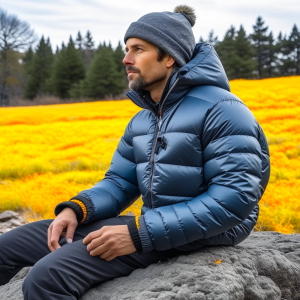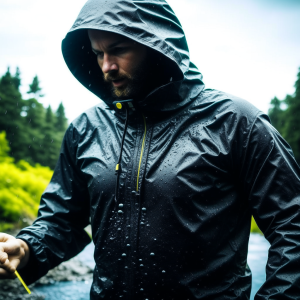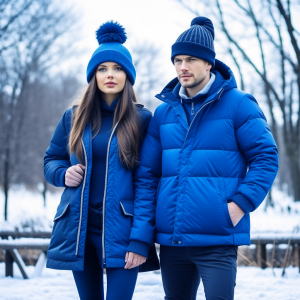Master the Art of Layering for Ultimate Warmth and Stylish Winter Attire
As the winter season approaches, bringing with it a chilling atmosphere, the quest for a perfect balance between warmth and trendy clothing becomes indispensable. With temperatures plummeting, the importance of layering our outfits cannot be overstated. Have you delved into the science of effective layering strategies? This article will comprehensively analyze the principles of layering, highlighting why specific garments outperform others in combating the harsh cold. Armed with this valuable information, you’ll be equipped to stay both cozy and fashionable throughout the winter months.
Layering is more than just a fashion statement; it is a calculated approach to enhancing thermal insulation and overall comfort in frigid environments. When temperatures dip, our bodies instinctively react by constricting blood vessels to conserve heat, which can often result in painfully cold extremities. However, this natural response may not be sufficient to keep us warm. This is where the strategic implementation of layering becomes essential, allowing us to establish a protective barrier against the cold while ensuring freedom of movement and comfort.

Establish Your Base Layer: The Key Component for Winter Warmth
The base layer is a fundamental element of your winter attire, meticulously designed to fit snugly against your skin while providing essential insulation. To fully appreciate the importance of this layer, it’s crucial to delve into the nuances of moisture control and its significant impact on your warmth and comfort during the colder months. Understanding these principles will empower you to make informed choices about materials and designs that will maximize the effectiveness of your base layer.
Harnessing the Power of Moisture-Wicking Fabrics for Enhanced Comfort
Selecting the ideal fabric for your base layer is crucial for effective moisture management. The significance of moisture-wicking capabilities cannot be overlooked. These specially engineered materials are proficient at drawing moisture away from your skin, whether from perspiration or external dampness, thereby preventing discomfort and chills. A high-quality base layer not only acts as a moisture barrier but also ensures you remain dry and warm, even in the most challenging weather conditions, greatly enhancing your overall comfort and ability to stay active outdoors.
Exploring Insulation: The Advantages of Merino Wool and Synthetic Fabrics
Next, we will investigate how materials like merino wool and synthetic fibers can significantly enhance the insulating properties of your base layer. Merino wool is renowned for its natural warmth and breathability, making it an exceptional choice; it offers effective insulation while adeptly wicking moisture away from your body. Conversely, synthetic fabrics such as polyester and nylon provide a fantastic combination of durability and insulation, creating a warm microclimate next to your skin that efficiently retains body heat, thus keeping you comfortable even in the most extreme conditions.
Achieving the Perfect Fit: Essential Considerations for Base Layer Efficiency
Picking the right fit for your base layer goes beyond simply selecting your usual size; it’s about optimizing performance and comfort. A snug fit ensures consistent contact with your skin, which enhances both insulation and moisture-wicking abilities. However, it’s crucial to find the right balance—too tight can restrict movement and comfort, while too loose may reduce effectiveness. Take into account your activity level and layering strategy to ensure that your base layer integrates seamlessly with your winter wardrobe, allowing you to enjoy all your favorite winter activities.
Ultimately, the base layer is not merely an article of clothing; it functions as an intricate moisture-wicking and insulating barrier against the severe winter elements. By understanding the unique properties of materials like merino wool and synthetic fibers, in addition to mastering fit, you can elevate your base layer to a vital component of your overall defense against the cold.
Unlocking the Insulating Layer: Your Essential Tool for Heat Retention
 As we progress to the insulating layer, we shift our focus to its critical function in trapping and retaining heat around your body. This layer is vital to the science of heat retention, acting as a protective cocoon against the unforgiving elements of winter. We will explore essential factors such as warmth-to-weight ratios, the benefits of down insulation, and the eco-friendly characteristics of synthetic alternatives, all of which contribute to effective heat regulation.
As we progress to the insulating layer, we shift our focus to its critical function in trapping and retaining heat around your body. This layer is vital to the science of heat retention, acting as a protective cocoon against the unforgiving elements of winter. We will explore essential factors such as warmth-to-weight ratios, the benefits of down insulation, and the eco-friendly characteristics of synthetic alternatives, all of which contribute to effective heat regulation.
Understanding Warmth-to-Weight Ratios for Optimal Insulation
Grasping the concept of warmth-to-weight ratios is essential when selecting an insulating layer. This principle emphasizes that insulation materials should provide exceptional warmth without introducing unnecessary bulk. Essentially, it’s about maximizing warmth while minimizing weight, allowing for fluid and comfortable movement. This balance is particularly crucial for those who desire insulation without feeling weighed down, thus enabling unrestricted activity in cold conditions.
Down Insulation: Lightweight Warmth for Adventurers
Down insulation is widely regarded as the top choice for individuals seeking remarkable warmth in a lightweight format. Harvested from the soft feathers of ducks and geese, down is celebrated for its extraordinary warmth-to-weight ratio. Its lightweight and compressible nature makes it perfect for winter enthusiasts who require effective insulation without sacrificing mobility. Recognizing the allure of down insulation is pivotal in understanding its function in crafting an insulating layer that embodies warmth, comfort, and flexibility.
Choosing Synthetic Insulation: Ethical Warmth for Any Climate
Synthetic insulation materials, primarily derived from polyester fibers, have emerged as popular ethical alternatives in the insulation landscape. What distinguishes synthetic insulation is its ability to retain warmth even in damp conditions, an area where down may struggle. This resilience in unpredictable weather makes synthetic fabrics suitable for a variety of climates. Furthermore, opting for synthetic options aligns with ethical considerations, enabling you to enjoy warmth without compromising your values or the environment.
Selecting the Right Thickness: Precision in Insulation Choice
Choosing the appropriate thickness for your insulating layer requires careful consideration; precision is essential. Assess the anticipated level of cold exposure along with your layering strategy when determining thickness. In milder temperatures, a thinner insulating layer may suffice, whereas harsher conditions may necessitate a thicker, more robust option. By understanding the intricacies of insulation thickness, you can customize your insulating layer to meet the specific demands of your winter pursuits.
In the end, the insulating layer transcends traditional clothing roles, evolving into a strategic ally in the battle against the cold. By navigating the complexities of warmth-to-weight ratios, recognizing the advantages of down insulation and synthetic alternatives, and providing insights on thickness selection, we transform the insulating layer into a calculated defense mechanism against winter’s icy grasp.
Your Outermost Layer: The Ultimate Defense Against Frigid Conditions
The outermost layer acts as your essential barrier against biting winds and freezing temperatures. This layer serves dual purposes: it protects against environmental elements while playing a critical role in moisture management. As we delve deeper into the outer layer, we will uncover the significance of breathability, the transformative effects of DWR finishes and Gore-Tex membranes, and the vital windproof features that enhance overall insulation efficiency.
Emphasizing Breathability: The Cornerstone of Comfort and Moisture Control
Often underestimated, breathability is a crucial attribute of the outer layer that significantly influences overall comfort. This characteristic refers to the fabric’s ability to permit sweat vapor to escape from your body while simultaneously preventing external moisture from penetrating. Achieving this delicate equilibrium keeps you dry and comfortable, thus alleviating the chilling effects of trapped moisture. A breathable outer layer is essential for maintaining a cozy microclimate within your clothing, ensuring exceptional comfort during inclement weather.
DWR Finishes and Gore-Tex: Leading the Charge in Waterproof Technology
 DWR (Durable Water Repellent) coatings and Gore-Tex membranes are at the forefront of cold-weather outerwear technology. DWR finishes impart water-repellent capabilities to fabrics, establishing a formidable barrier against rain, sleet, and snow. Gore-Tex and similar technologies enhance waterproofing by providing an impeccable combination of impermeability and breathability. Understanding how these technologies collaborate is essential for staying dry and comfortable, even in the most extreme weather conditions.
DWR (Durable Water Repellent) coatings and Gore-Tex membranes are at the forefront of cold-weather outerwear technology. DWR finishes impart water-repellent capabilities to fabrics, establishing a formidable barrier against rain, sleet, and snow. Gore-Tex and similar technologies enhance waterproofing by providing an impeccable combination of impermeability and breathability. Understanding how these technologies collaborate is essential for staying dry and comfortable, even in the most extreme weather conditions.
Windproof Features: Strengthening Your Defense Against Chilly Winds
Windproof characteristics are vital during freezing weather, particularly when biting gusts can penetrate even the toughest fabrics. The windproof outer layer acts as an impenetrable barrier against cold air, enhancing comfort while safeguarding the insulation of the inner layers. By obstructing frigid winds, your outer layer becomes a formidable protector, ensuring that your carefully selected layers work together to keep you warm and shielded from harsh elements.
In essence, the outermost layer is more than just a protective shell; it serves as a sophisticated barrier that expertly balances breathability and waterproofing. By grasping the importance of breathability, exploring advancements in DWR finishes and Gore-Tex membranes, and understanding the essential role of windproof features, we elevate the outer layer into a dynamic garment that excels in style, functionality, and weather resistance.
Practical Tips for Maximizing Warmth and Style This Winter
With a solid grasp on effective layering techniques established, let’s delve into actionable tips and strategies to enhance your cold-weather experience, seamlessly merging warmth with enduring style. Accessories play an instrumental role in winter attire, often serving as unsung heroes that can elevate your overall look. From the crucial warmth provided by carefully selected gloves to the stylish flair of a cozy hat, not to mention the comfort offered by thermal socks, these seemingly minor details are vital in achieving a fashionable and comfortable winter ensemble.
The Indispensable Role of Accessories: Beyond Aesthetic Appeal
Accessories serve as more than mere decorative elements; they are essential components of your defense against the cold. Beyond their visual appeal, items such as gloves, hats, and thermal socks fulfill crucial roles in enhancing your overall warmth. By thoughtfully incorporating these accessories into your winter wardrobe, you can ensure that every part of your body is shielded from the chill, effectively preventing valuable body heat from escaping into the frigid air.
Investing in Quality Accessories: Recommendations for Ultimate Warmth
The pursuit of warmth extends beyond your base and insulating layers; it also involves the careful selection of accessories. Invest in high-quality gloves made from insulating materials like fleece or lined leather to create a formidable barrier against the cold. A warm hat with additional insulation or a cozy faux-fur lining not only enhances style but also aids in heat retention. Opt for thermal socks crafted from merino wool or advanced synthetic blends to ensure maximum warmth and effective moisture management.
Fashion-Forward Strategies: Merging Functionality with Style
Staying warm in freezing temperatures doesn’t have to compromise your sense of style. Embrace these savvy styling techniques to navigate the winter landscape with confidence. Experiment with layering various textures in your outfit to create visual interest while simultaneously enhancing insulation. Choose winter-appropriate colors that complement the snowy background, and don’t hesitate to accessorize with vibrant pieces like a bold scarf or fashionable earmuffs to elevate your overall appearance.
Ultimately, accessories are the often-overlooked architects of a well-rounded winter outfit. They not only boost warmth but also enable you to express your personal style, even in the coldest conditions. By selecting high-quality accessories and thoughtfully styling your winter wardrobe, you can conquer the chill while showcasing undeniable elegance.
Embrace the Perfect Fusion of Style and Functionality in Your Winter Wardrobe
As we wrap up our exploration of conquering the cold, it’s essential to recognize the importance of style in winter clothing. Dressing appropriately for cold weather doesn’t entail sacrificing your fashion sense; rather, the current fashion landscape celebrates the marriage of functionality and flair. Numerous outdoor and fashion brands have acknowledged and embraced the demand for winter gear that not only keeps you warm but also exudes confidence and contemporary elegance.
The Transformation of Cold-Weather Clothing: A Stylish New Era
 The cold-weather clothing industry is undergoing a renaissance, where winter gear transcends mere functionality to embody innovation and style. Designers and brands are increasingly recognizing the necessity for clothing that seamlessly merges practicality with visual appeal. This shift has ushered in a new era of outerwear that not only provides warmth but also captivates with its aesthetic charm.
The cold-weather clothing industry is undergoing a renaissance, where winter gear transcends mere functionality to embody innovation and style. Designers and brands are increasingly recognizing the necessity for clothing that seamlessly merges practicality with visual appeal. This shift has ushered in a new era of outerwear that not only provides warmth but also captivates with its aesthetic charm.
Pioneering Brands: Where Style Meets Function
Several brands are leading the way in this evolution of style, adeptly merging fashion with functionality in their winter apparel. Canada Goose is renowned for its luxurious down coats that deliver exceptional warmth without sacrificing style. The North Face incorporates cutting-edge technology into its designs, creating outerwear that harmonizes chic aesthetics with practical functionality. Meanwhile, Moncler has redefined the puffer jacket, transforming it into a high-fashion statement piece, proving that winter clothing can indeed be both functional and runway-ready.
Effective Styling Tips: Amplify Your Winter Fashion Game
Now, let’s explore how to effectively blend warmth and style in your winter outfits. Choose standout pieces that fulfill both functional and aesthetic purposes, such as a beautifully tailored wool coat or a sleek parka that serves as the centerpiece of your ensemble. Experiment with layering a chunky knit sweater over a fitted jacket for a chic yet cozy look. Don’t hesitate to introduce vibrant colors into your winter wardrobe by accessorizing with striking scarves or trendy boots.
Ultimately, embracing style in the cold is no longer a contradiction; it’s a vibrant reality shaped by a dynamic fashion industry. As fashionable cold-weather gear emerges, championed by innovative brands, the narrative shifts from mere survival to personal expression. So, immerse yourself in this stylish renaissance, select pieces that empower you, and redefine fashion amid the wintry embrace of the season.
The post Cold Weather Clothing Layers: The Science Explained appeared first on Survival Bite.
The Article Cold Weather Clothing Layers Explained: Understanding the Science Was Found On https://limitsofstrategy.com
The Article Cold Weather Clothing Layers: The Science Behind Them First Appeared ON
: https://ad4sc.com














Yazmin Darwish
Layering truly transforms the way we experience winter, doesn’t it? I’ve found that embracing this art not only keeps me warm but allows for such creativity in my wardrobe. It’s fascinating how each layer serves a specific purpose—like how a thermal base layer can trap warmth, while an insulating middle layer can trap that heat effectively. Personally, I love incorporating contrasting textures; for instance, I often pair a soft wool sweater with a sleek puffer jacket. The visual depth not only enhances my style but also prompts others to think about how to mix various materials.